What is the best solar panel orientation and inclination? The orientation and inclination of the solar panels are two of the most important factors if you want to obtain the maximum performance from a photovoltaic installation. In this article, we explain how you should place your solar panels to get maximum energy production.
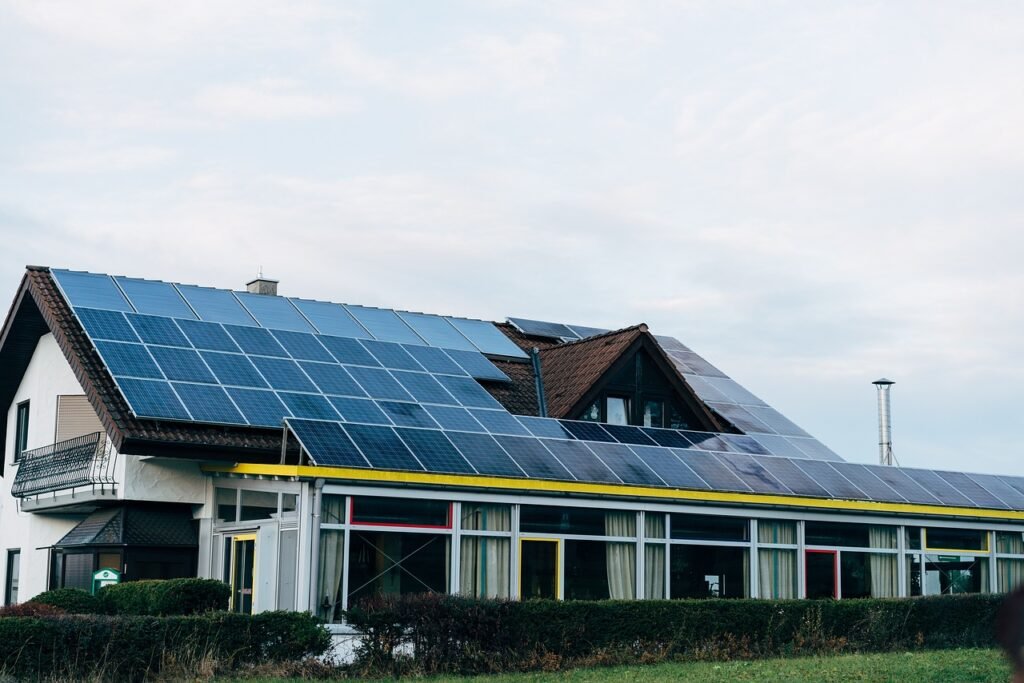
What is the Proper Solar Panel Orientation in the UK?
The photovoltaic panels must be oriented as far as possible towards the south to obtain the maximum performance. Also, you should install them in a place free of shadows. This is because the south orientation guarantees that the solar panels are located perpendicularly when the sun offers its greatest solar radiation during the day. As a consequence, the energy production of the photovoltaic system will be maximized.
There are other valid alternatives if you can’t direct the photovoltaic self-consumption system towards the south. You can change the direction a few degrees without having considerable production losses. Specifically, it is worth knowing that if the solar panels are oriented with a deviation of up to 45º, the annual electricity generation will vary by approximately 3%. If it is not possible to locate the panels in a southerly direction, the following alternatives are recommended:
▷ West Orientation: it is an equally valid alternative if you can’t orient your photovoltaic system towards the south. Depending on the consumption profile, it may be the best alternative. If electricity use is primarily during the afternoon hours (when school hours or certain jobs have ended) it may be even more convenient than facing south. This is because the energy production of the panels facing west is higher from 2:00 – 3:00 p.m. until dusk.
▷ East-West Orientation: more and more solar installations are opting for an orientation that combines east and west. This alternative combines half of the solar panels facing East and the other half facing West. The main advantages of this orientation are:
- The more compact installation increases the density of energy generation.
- Wind pressure is reduced compared to a southerly orientation.
- Less counterweight when securing the solar panels to the roof.
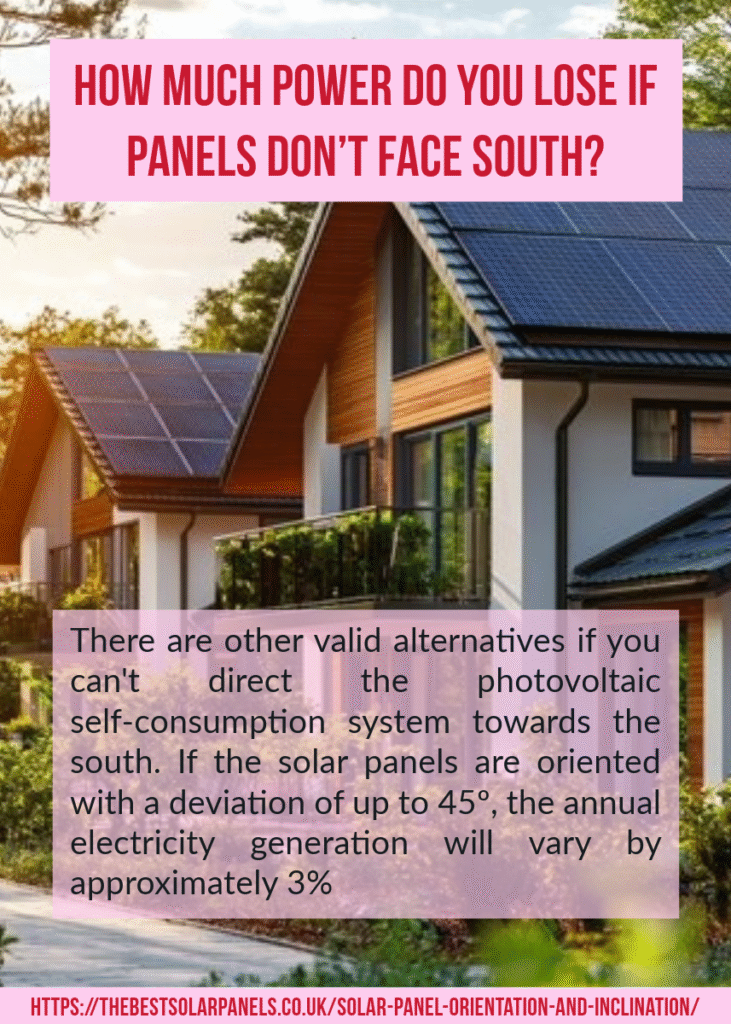
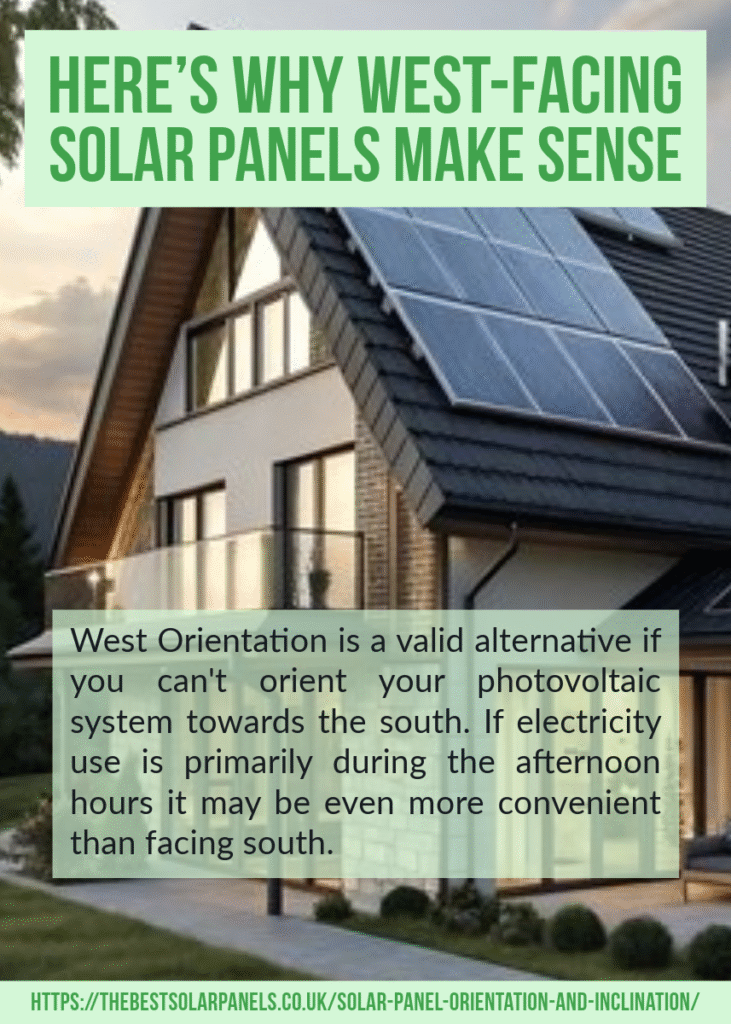
Is it convenient to locate solar panels facing North?
No. It is not advisable to orient solar installations towards the north. If this is the only possible option to locate the solar panels, there would be the possibility of placing solar structures to counteract the inclination of the roof. However, it should be an extreme option, and in these cases, we don’t recommend to carry out the installation for the following reasons:
- Electricity generation will be lower.
- The final price of the installation will be higher because of the structures.
As a consequence of the previous two, the profitability of the system will be lower.
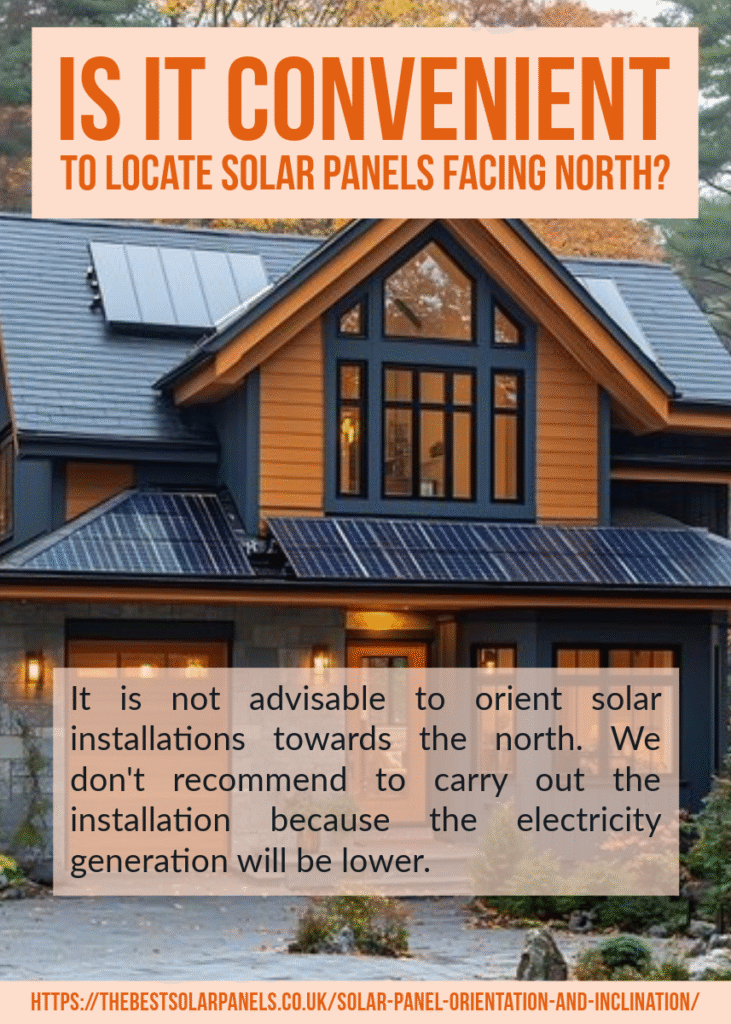
How do shadows affect a solar panel installation?
Shadows in self-consumption facilities can cause the solar panels to malfunction by obstructing the direct passage of solar radiation. For this reason, it is crucial to avoid the existence of shadows both at the time of system start-up and during the useful life of the installation. So, you will avoid negative effects, which are mainly:
- The power loss of the complete photovoltaic system.
- Energy fluctuations.
- Damage to the internal components of the solar panel.
The existence of shadows on solar panels reverses the electrical production process. So, the photovoltaic modules go from generating electrical energy to consuming it.
To prevent shading in one (or several areas) from endangering the electrical production of the entire installation, the solar panels have bypass diodes. These diodes conduct the electric current through an area other than the shaded area to avoid the appearance of hot spots.
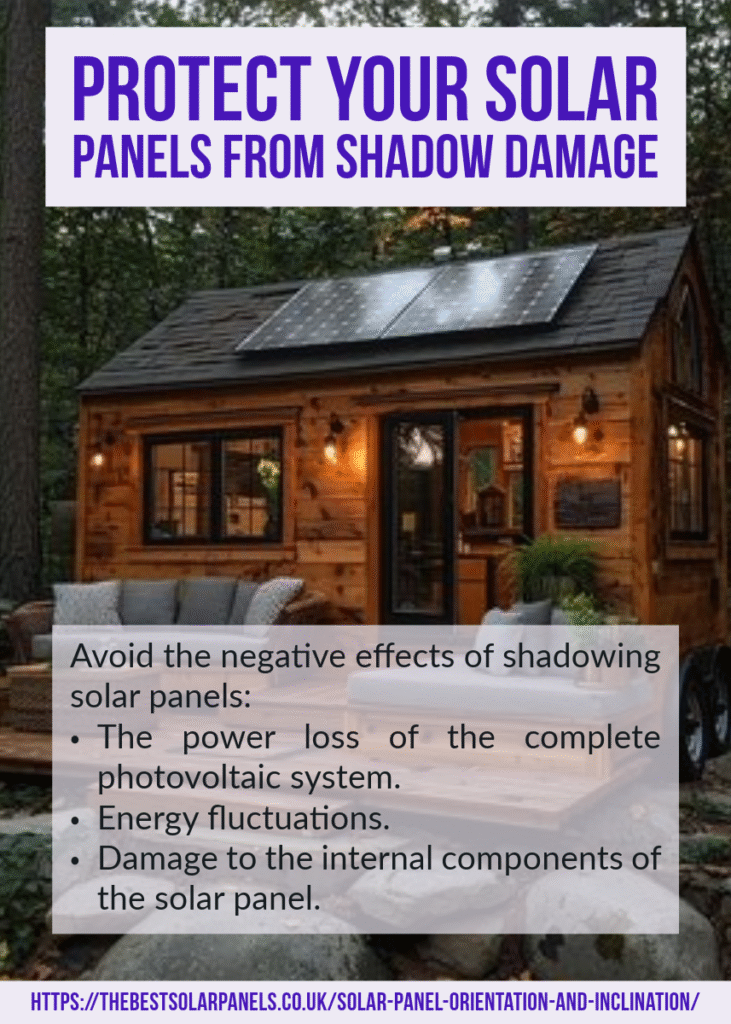
What inclination should the photovoltaic panels have?
When determining the ideal inclination angle for photovoltaic panels, you should know what time of year you will consume the most electrical energy. For example:
- On the one hand, if consumption is going to be primarily during the summer, the degree of inclination should be optimized for those months.
- On the other hand, if the installation is going to be used constantly, it is most advisable to provide an angle of inclination that optimizes electricity generation on average throughout the year.
Likewise, the inclination is also conditioned by the geographical area in which the solar panels are installed.
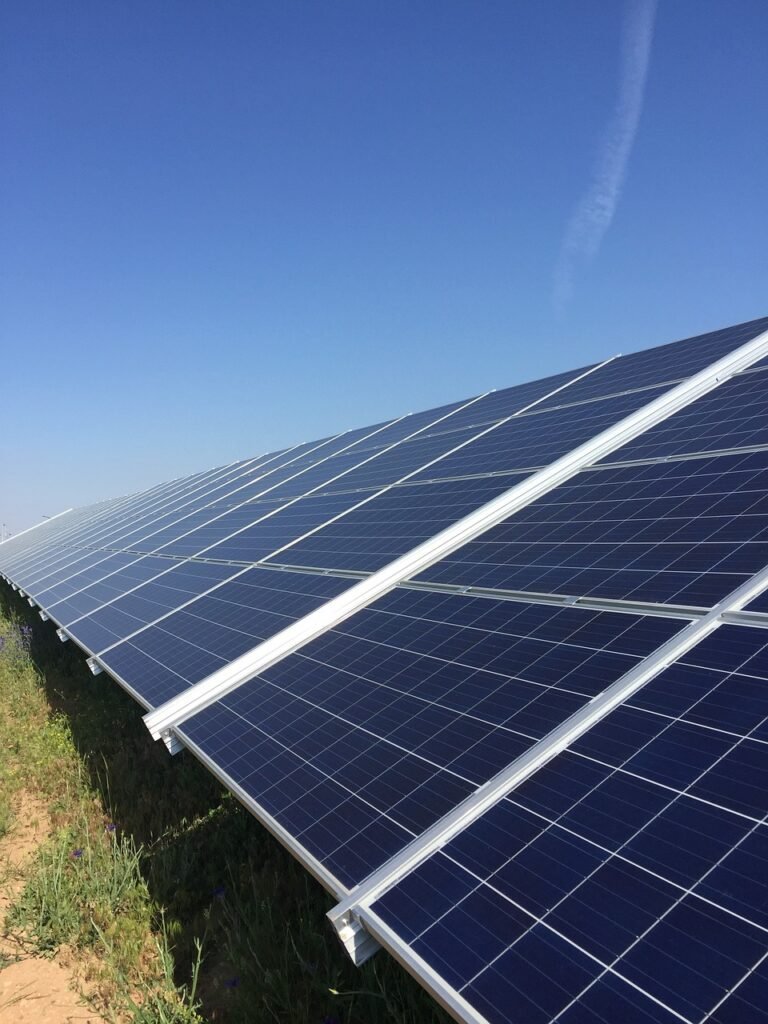
Optimal tilting of solar panels in UK regions.
Determining the optimal tilt angle for solar panels in different regions of England involves considering factors such as latitude, climate, and specific geographical characteristics. The goal is to maximize sunlight exposure throughout the year, accounting for the changing position of the sun in the sky. Here’s a detailed breakdown of the recommended solar panel tilt for different regions in the UK:
Scotland
- Edinburgh and Eastern Scotland:
- Optimal Tilt Angle: Approximately 35 to 40 degrees
- Explanation: Eastern regions, including Edinburgh, may experience reduced sunlight compared to southern areas. A steeper tilt angle helps capture sunlight more effectively, especially during the winter months when the sun is lower in the sky.
- Glasgow and Central Scotland:
- Optimal Tilt Angle: Around 30 to 35 degrees
- Explanation: Central regions, including Glasgow, benefit from a moderate tilt angle that balances sunlight capture throughout the year. This angle allows for effective energy generation during both winter and summer months.
- Aberdeen and Northern Scotland:
- Optimal Tilt Angle: Higher, around 35 to 40 degrees
- Explanation: Northern regions may experience reduced sunlight compared to central and southern areas. A slightly steeper tilt angle helps compensate for lower sun angles, particularly during the winter months.
- Inverness and Highland Region:
- Optimal Tilt Angle: Approximately 35 to 40 degrees
- Explanation: Highland regions, including Inverness, may have more variable weather conditions. A steeper tilt angle helps maximize energy capture during periods of less direct sunlight.
England
- London and Southeast England:
- Optimal Tilt Angle: Around 25 to 30 degrees
- Explanation: Southeastern regions, including London, generally receive more sunlight throughout the year. A lower tilt angle is optimal to capture sunlight efficiently across all seasons. This angle helps prevent overproduction during the summer while still maximizing energy generation during the winter.
- Southwest England (Cities like Bristol and Plymouth):
- Optimal Tilt Angle: Similar to Southeast England, around 25 to 30 degrees
- Explanation: The optimal tilt angle for the southwest is comparable to that of southeastern regions due to similar sunlight conditions.
- Birmingham and Central England:
- Optimal Tilt Angle: Approximately 30 to 35 degrees
- Explanation: Central regions, including Birmingham, benefit from a moderate tilt angle that balances sunlight capture throughout the year. This angle allows for effective energy generation during both winter and summer months.
- Manchester and Northwest England:
- Optimal Tilt Angle: Higher, around 35 to 40 degrees
- Explanation: Northwestern regions may experience reduced sunlight compared to central and southern areas. A slightly steeper tilt angle helps compensate for lower sun angles, particularly during the winter months.
- Leeds and Yorkshire:
- Optimal Tilt Angle: Around 30 to 35 degrees
- Explanation: Yorkshire and other regions in the north benefit from a moderate tilt angle that optimizes sunlight capture throughout the year.
- Newcastle and Northeast England:
- Optimal Tilt Angle: Higher, around 35 to 40 degrees
- Explanation: Northeastern regions, including Newcastle, experience less sunlight compared to southern areas. A steeper tilt angle helps capture sunlight more effectively, especially during the winter months when the sun is lower in the sky.
Wales
- Cardiff and South Wales:
- Optimal Tilt Angle: Around 30 to 35 degrees
- Explanation: Southern regions, including Cardiff, experience relatively more sunlight throughout the year. A moderate tilt angle is optimal to capture sunlight efficiently across all seasons.
- Swansea and Southwest Wales:
- Optimal Tilt Angle: Similar to South Wales, around 30 to 35 degrees
- Explanation: The optimal tilt angle for southwest Wales is comparable to that of southern regions due to similar sunlight conditions.
- Aberystwyth and Mid Wales:
- Optimal Tilt Angle: Approximately 30 to 35 degrees
- Explanation: Mid Wales benefits from a moderate tilt angle that balances sunlight capture throughout the year. This angle allows for effective energy generation during both winter and summer months.
- Bangor and North Wales:
- Optimal Tilt Angle: Higher, around 35 to 40 degrees
- Explanation: Northern regions, including Bangor, may experience reduced sunlight compared to central and southern areas. A slightly steeper tilt angle helps compensate for lower sun angles, particularly during the winter months.
Northern Ireland
- Belfast and Eastern Northern Ireland:
- Optimal Tilt Angle: Approximately 30 to 35 degrees
- Explanation: Eastern regions, including Belfast, benefit from a tilt angle that balances the capture of sunlight throughout the year. This angle allows for effective energy generation during both winter and summer months.
- Western Northern Ireland (Cities like Derry and Omagh):
- Optimal Tilt Angle: Slightly higher, around 35 to 40 degrees
- Explanation: Western regions of Northern Ireland, being closer to the Atlantic Ocean, may experience more overcast conditions. A slightly steeper tilt angle helps maximize energy capture during periods of less direct sunlight.
- Southern Northern Ireland (Cities like Newry):
- Optimal Tilt Angle: Similar to Eastern regions, around 30 to 35 degrees
- Explanation: Southern parts of Northern Ireland experience sun conditions similar to the eastern areas. Therefore, a moderate tilt angle is suitable for efficient energy generation.
- Northern Northern Ireland (Cities like Coleraine):
- Optimal Tilt Angle: Higher, around 35 to 40 degrees
- Explanation: Northern regions may experience reduced sunlight compared to southern areas. A slightly steeper tilt angle helps compensate for lower sun angles, particularly during the winter months.
Coastal Areas:
- Optimal Tilt Angle: Consideration for higher wind exposure may influence the tilt angle
- Explanation: Coastal regions may experience higher wind exposure, which becomes a crucial factor in solar panel installations. While the optimal tilt angle for energy generation remains a primary consideration, adjustments may be made to account for the increased wind load on the solar panels.
Conclusion
It’s important to note that these optimal tilt angles serve as general guidelines. Other site-specific factors, including shading, local topography, and building orientation, should be considered when determining the ideal tilt for solar panels in a specific location. Additionally, advanced solar installations may use tracking systems that adjust the tilt and orientation of panels throughout the day to optimize sunlight capture.
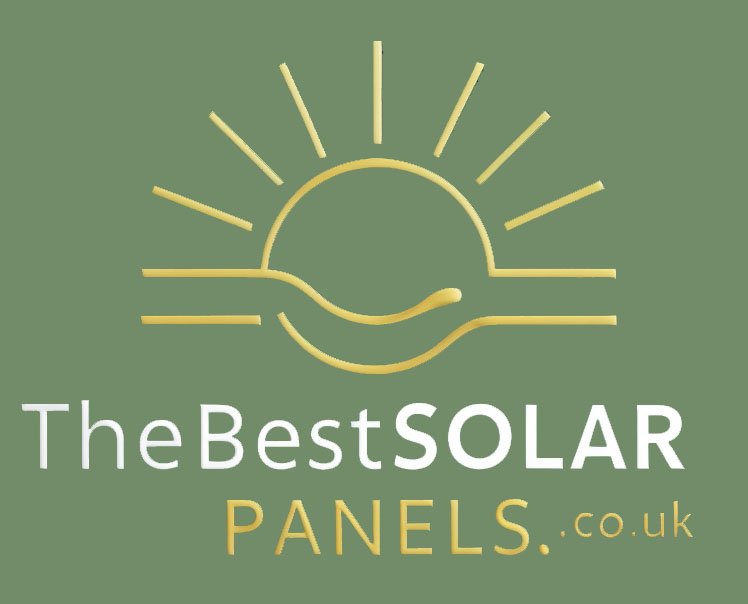


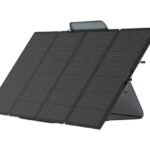
Leave a Reply